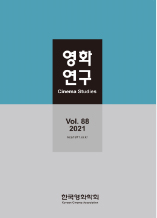- 영문명
- The Eco-Slow Aesthetics of Slow Cinema and Its Nonconscious Experience
- 발행기관
- 한국영화학회
- 저자명
- 박제철
- 간행물 정보
- 『영화연구』제88호, 459~486쪽, 전체 28쪽
- 주제분류
- 예술체육 > 예술일반
- 파일형태
- 발행일자
- 2021.06.30
6,160원
구매일시로부터 72시간 이내에 다운로드 가능합니다.
이 학술논문 정보는 (주)교보문고와 각 발행기관 사이에 저작물 이용 계약이 체결된 것으로, 교보문고를 통해 제공되고 있습니다.

국문 초록
21세기에 접어들며 전 세계는 지구온난화, 기후변화, 생물종 다양성 감소 등인간중심주의가 지구에 미친 생태학적 악영향에 대해 매우 심각한 우려를 표명하고 있으며 이에 대처하기 위해 세계에 대한 새로운 경험 양식과 새로운 삶의 양식을 요청하고 있다. 본 논문은 인간중심주의에 대한 이 같은 근본적인 반성의 촉구와 새로운 윤리의 필요성이 제기되는 맥락에서 슬로우 시네마가 이러한 도전에 대처하는데 어떻게 기여할 수 있을지를 탐구한다. 필자는 슬로우 시네마 내에서 일어난 에코-슬로우 미학적 전회가 어떻게 인간중심적 인지를 넘어 세계를탈인간중심적으로 경험할 가능성을 열어주는지를 이론적으로 해명한다. 이를 위해 필자는 먼저 슬로우 시네마의 주요 선행연구를 개괄적으로 살펴보면서 많은슬로우 시네마 작품 속에 여전히 존재하는 인간중심주의의 한계를 문제시하고에코-슬로우 시네마 미학을 탐구하기 시작한 최근의 몇 몇 연구를 검토한다. 이어 필자는 에코-슬로우 시네마가 관객에게 선사하는 ‘탈인간중심적’ 경험을 보다정교하게 이론화하기 위해 신경과학 연구에서 제안된 ‘의식적 인지’와 ‘비의식적인지’의 구분을 캐서린 헤일즈의 논의를 중심으로 살펴본다. 이러한 개념들에 대한 이해를 바탕으로 필자는 토르벤 그로달의 신경과학적 영화연구를 비판적으로경유함으로써 에코-슬로우 시네마가 관객에게 선사하는 비인간중심적 경험을 이론적으로 해명하고 이를 제임스 베닝의 <13개의 호수>(2004)와 아피찻퐁 위라세타쿤의 <열대병>(2004)에 대한 분석을 통해 구체화한다.
영문 초록
Since the beginning of the 21st century, the world has been expressing serious concerns about the ecological consequences of anthropocentrism, such as global warming, climate change and biodiversity reduction, and has been calling for new modes of experiencing the world and new lifestyles to address these challenges. This paper aims to explore how slow cinema can contribute to addressing these challenges at the moment when we feel the need for a critical reflection on anthropocentrism and a new non-anthropocentric ethics. I would like to theoretically explain how the eco-slow aesthetic turn in the slow cinema opens up the possibility of experiencing the world in a non-anthropocentric manner beyond the limit of anthropocentrism. For this purpose, in giving an overview of existing slow cinema scholarship, I examine some recent discussions that explore eco-slow aesthetics, and problematize the anthropocentric tendency that still characterizes many slow cinema works. I then draw attention to Katherine Hayles’s discussion of the distinction between “conscious cognition” and “nonconscious cognition” proposed in neuroscience research to theorize in a more elaborate manner the non-anthropocentric experience that eco-slow cinema offers the audience. Drawing on these concepts, I also critically engage Torben Grodal’s neuroscientific model of film experience to theoretically elucidate the eco-slow cinema’s non-anthropocentric experience and illustrate my theoretical points by specifically examining James Benning’s 13 Lakes (2004) and Apichatpong Weerasethakul’s Tropical Malady (2004).
목차
1. 들어가며
2. 슬로우 시네마의 에코-슬로우 미학적 전회
3. 신경과학적 관점에서 본 정동 경험과 그 비인간중심적 함의
4. 에코-슬로우 시네마 경험의 신경과학적 이론화
5. 나가며: 에코-슬로우 시네마의 미학과 윤리학
키워드
해당간행물 수록 논문
- 토드 헤인즈의 <캐롤(Carol)>의 영화적 공간
- 비평적 창작으로서의 각색
- 코로나19와 영화제의 미래
- 복수의 다층성과 사적 복수의 정당성
- 앙리 르페브르의 도시적 공간담론을 통해 본 지아장커(賈樟柯) 영화에 재현된 도시 공간 (1998-2018)
- <세브린느>
- 권역 단위의 국제공동제작이 유럽 영화시장에 미치는 영향과 의의
- 한국 시네마스코프 전환 시기의 영화 <여사장>의 스타일 분석
- 슬로우 시네마의 에코-슬로우 미학과 그 비의식적 경험
- 비대면 영화교육에 대한 전망
- 아날로그 미디어 노스탤지어와 디지털 영화
- 영화연구 게재논문 투고, 심사(수정), 게재확정일 외
- 게토영화와 갱스터
- 언택트 시대, 영화제의 변화상과 새로운 가능성
- 앙드레 바쟁의 영상 존재론과 허우샤오시엔 영화의 롱 테이크 유사성
- 혼돈의 사회와 도시의 리듬
- 영화연구 제88호 목차
참고문헌
관련논문
예술체육 > 예술일반분야 BEST
- 생성형 AI 도구와 디자이너의 협업 프로세스 개발 - 이미지를 통한 아이디어 확산에서 고해상도 렌더링까지
- 영화 [올드보이]와 소포클레스 「오이디푸스 왕」의 상동성 연구
- ‘일과 삶의 균형(Work-Life Balance)’ 척도 개발을 위한 연구
예술체육 > 예술일반분야 NEW
- Z세대 생활체육 동호인들의 SNS 중독 경향성과 불안정 성인애착이 완벽주의적 자기제시 및 우울에 미치는 영향
- 즐거움과 몰입을 통한 수익성 기대가 NFT 구매 의도에 미치는 매개효과 분석: UTAUT2와 합리적 무관심(RI)을 중심으로
- 생태체험이 청소년의 자연친밀감, 환경태도, 환경행동의도에 미치는 영향
최근 이용한 논문
교보eBook 첫 방문을 환영 합니다!

신규가입 혜택 지급이 완료 되었습니다.
바로 사용 가능한 교보e캐시 1,000원 (유효기간 7일)
지금 바로 교보eBook의 다양한 콘텐츠를 이용해 보세요!



